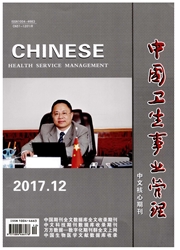

 中文摘要:
中文摘要:
目的:通过对居民卫生服务需要与利用情况及其影响因素进行探讨,为各级卫生决策部门提供卫生服务的政策支持。方法:在所调查区域分层整群抽样,问卷访谈获得样本信息,统计学分析方法主要采用非条件logistic回归和卡方检验。结果:被调查居民两周患病率为11.70%,影响两周患病的因素有年龄、婚姻状况和是否在业(P〈0.05);慢性病患病率为10.02%,年龄、是否就业和医疗保障因素与慢性病的发生有关联(P〈0.05);居民两周患病就诊率为86.16%,住院率为7.14%。结论:相对于全国第4次卫生服务调查的结果,本区居民健康状况较好,对卫生服务的利用率也较高,可针对分析结果的重点人群提高卫生服务的效率,并引导居民更多的使用除医疗服务之外的公共卫生服务。
 英文摘要:
英文摘要:
Objective To study the status of health services need and utilization and its influencing factors, and provide policy support for the governmental decision-making of health services. Methods Samples were chosen with stratified cluster sampling method and surveyed with self- designed questionnaires. Data was analyzed by unconditional logistic regression method and chi- square test. Results The residents' two-week prevalence was 11.70%, which was significantly influenced by factors of age, marital status and employment ( P 〈 0.05 ). The prevalence of chronic illnesses was 10.02%, which was significantly related with age, employment and medical insurances. The outpatient rate in the latest two weeks was 86.16%. And the hospitalization rate was 7. 14%. Conclusion The residents' health condition was better than the result of the fourth national health services survey in China. And their utilization rate of health services was higher. However, the efficiency of health services can be improved by focusing on concerned people and guiding general people into utilize the public health services.
 同期刊论文项目
同期刊论文项目
 同项目期刊论文
同项目期刊论文
 期刊信息
期刊信息
